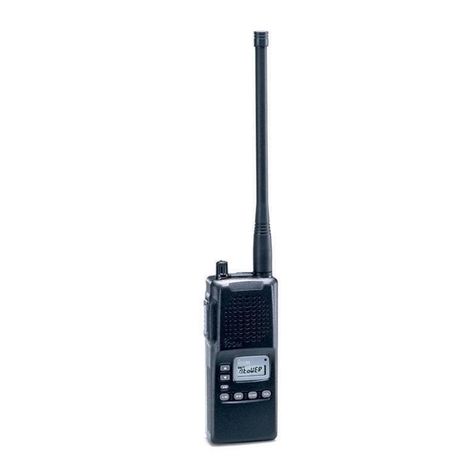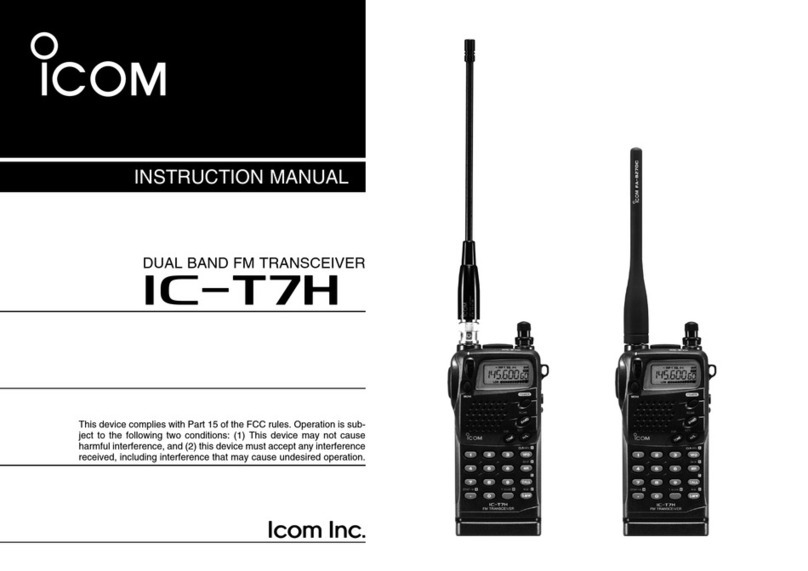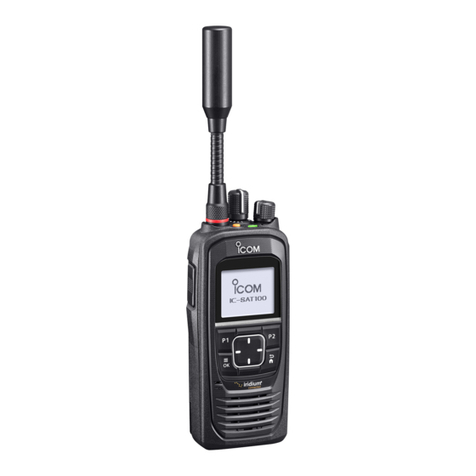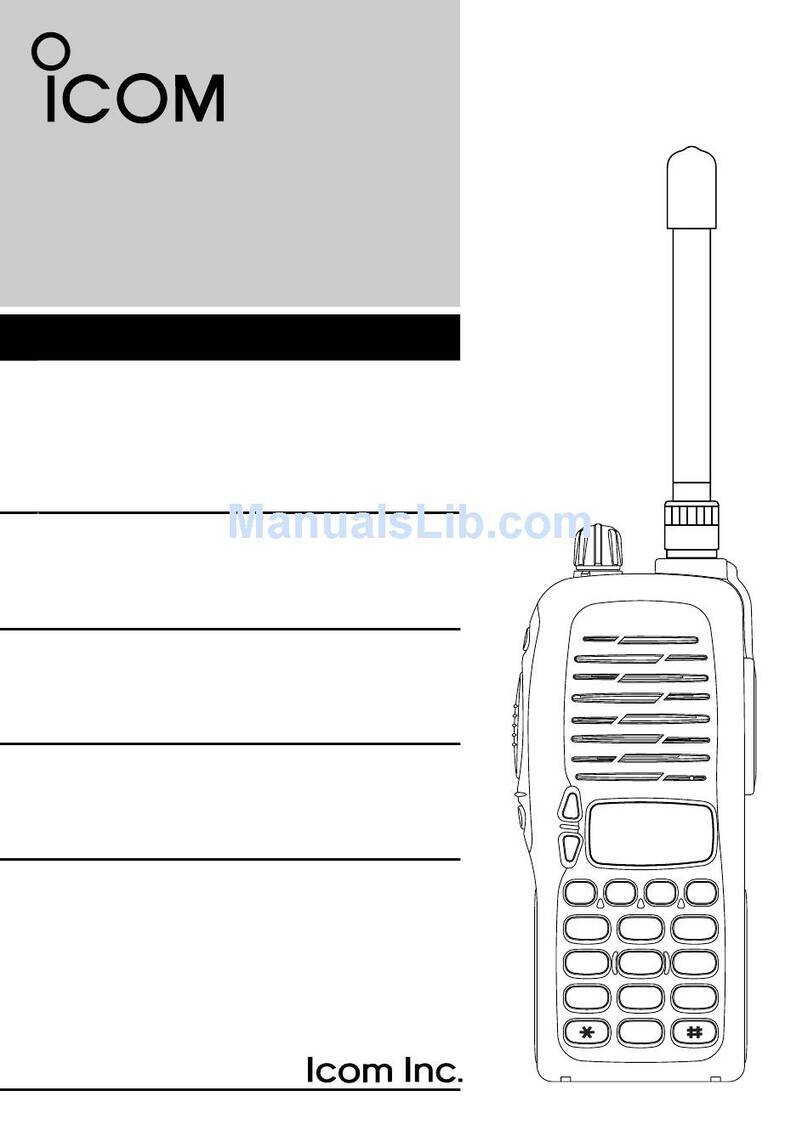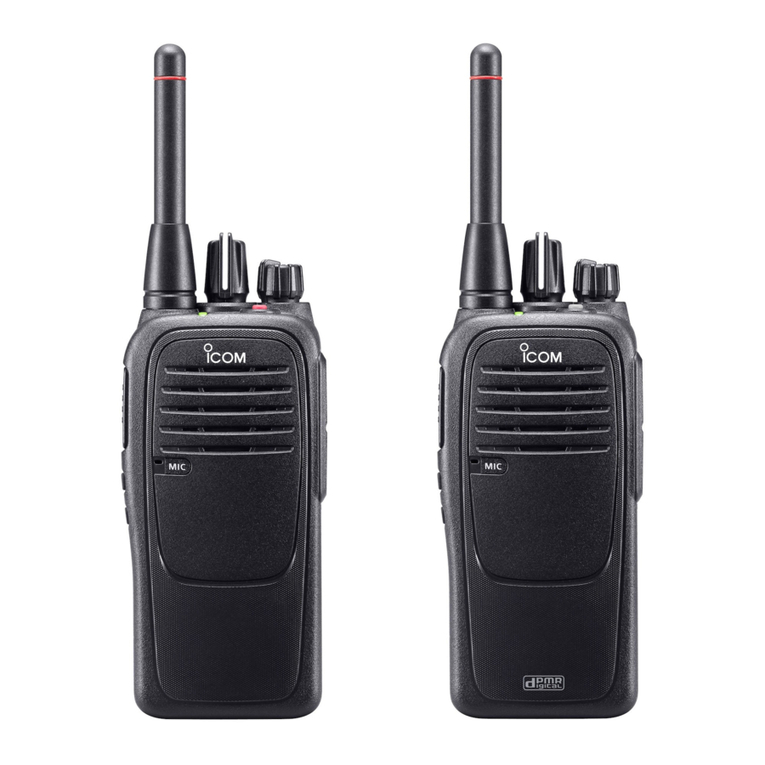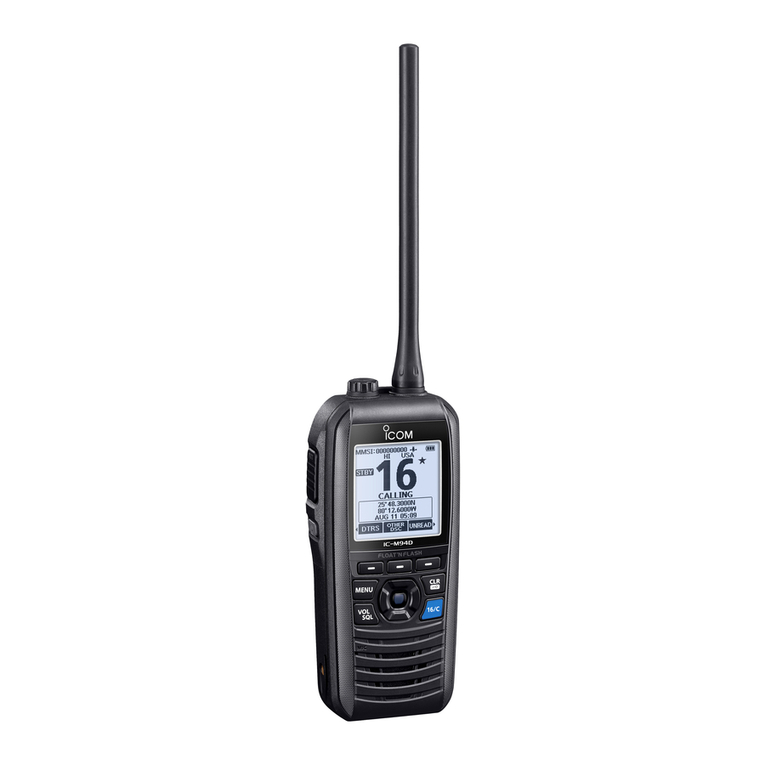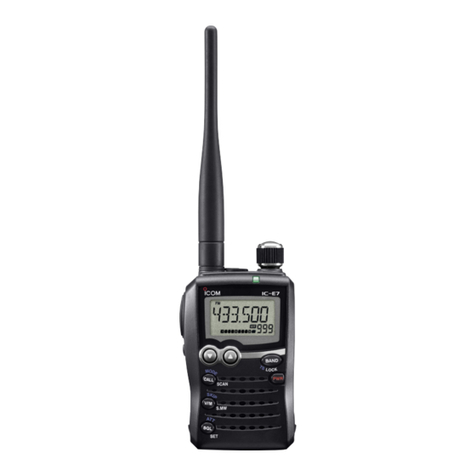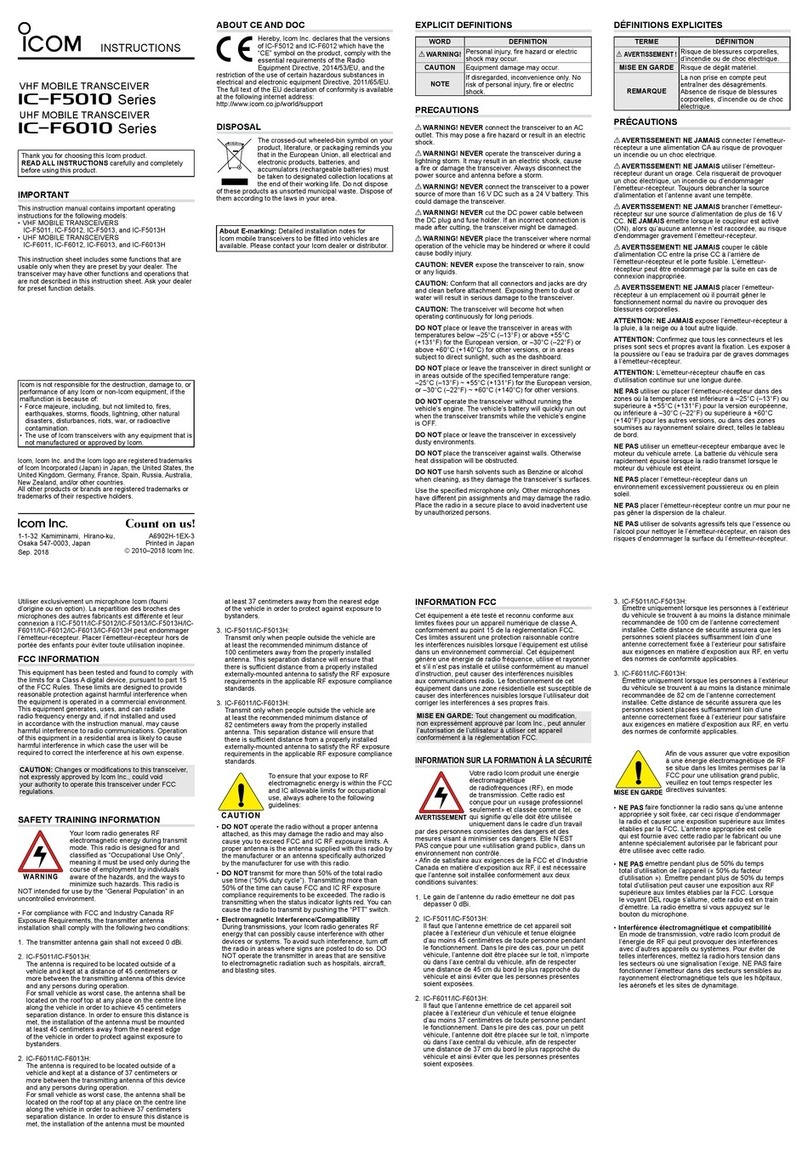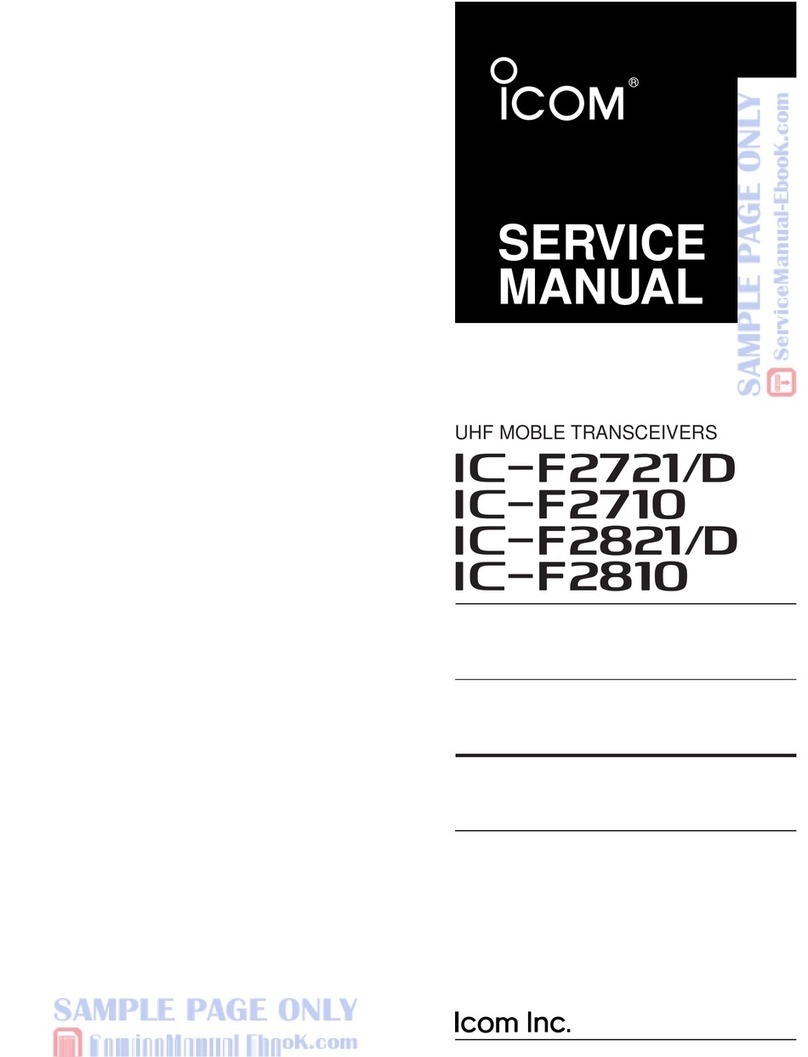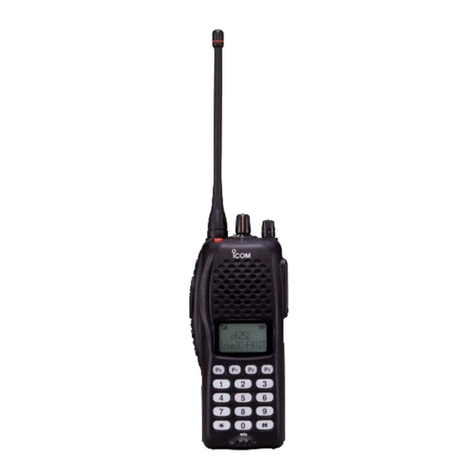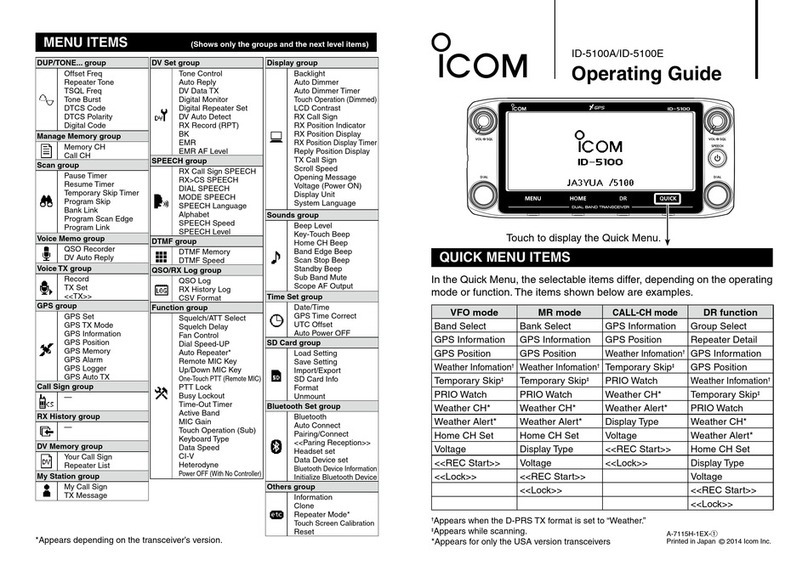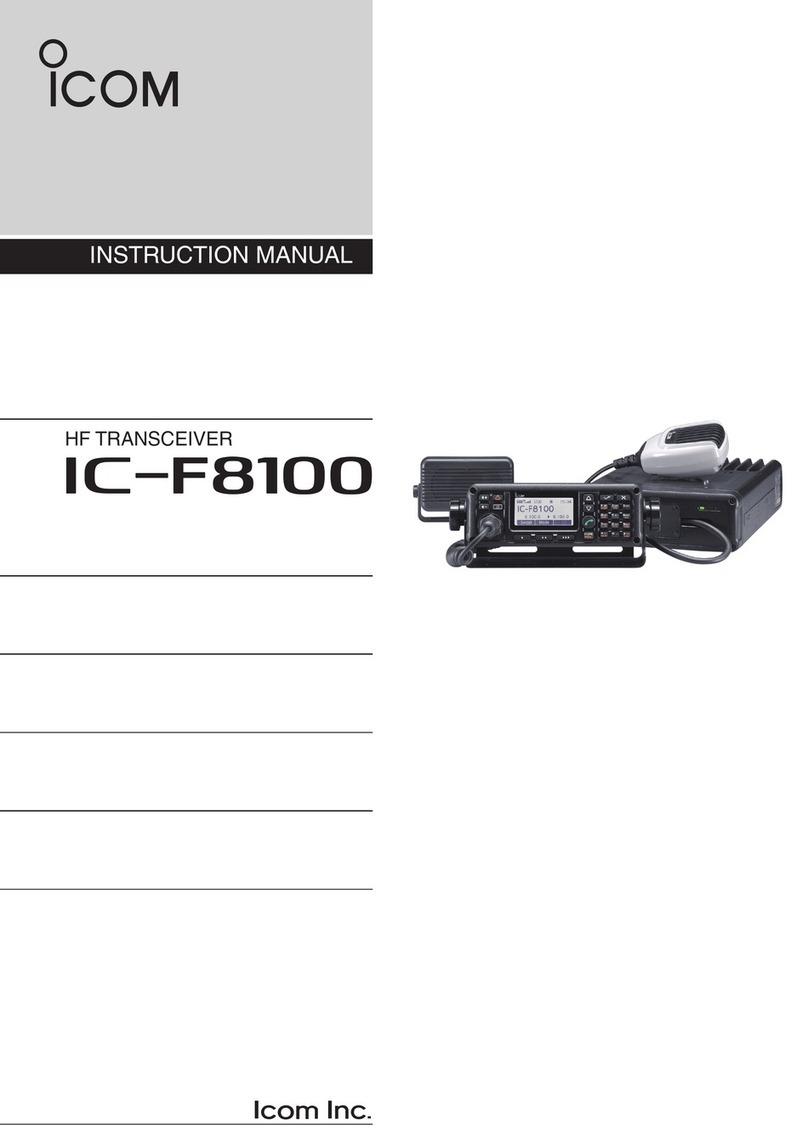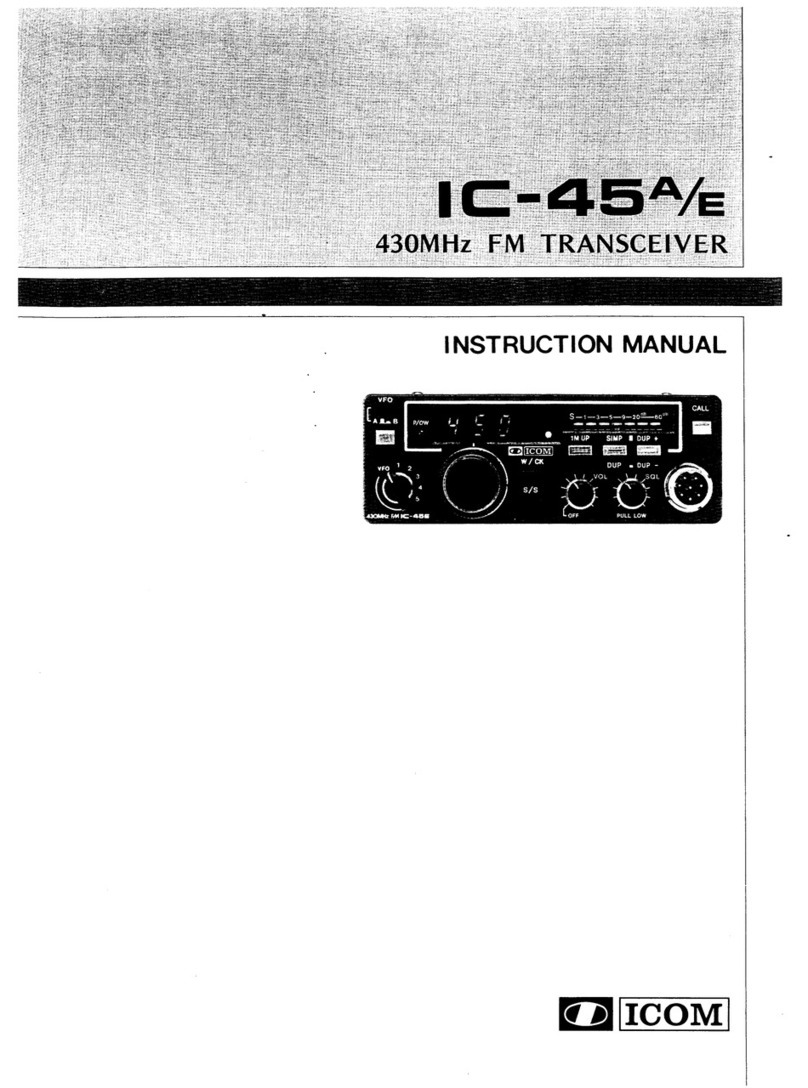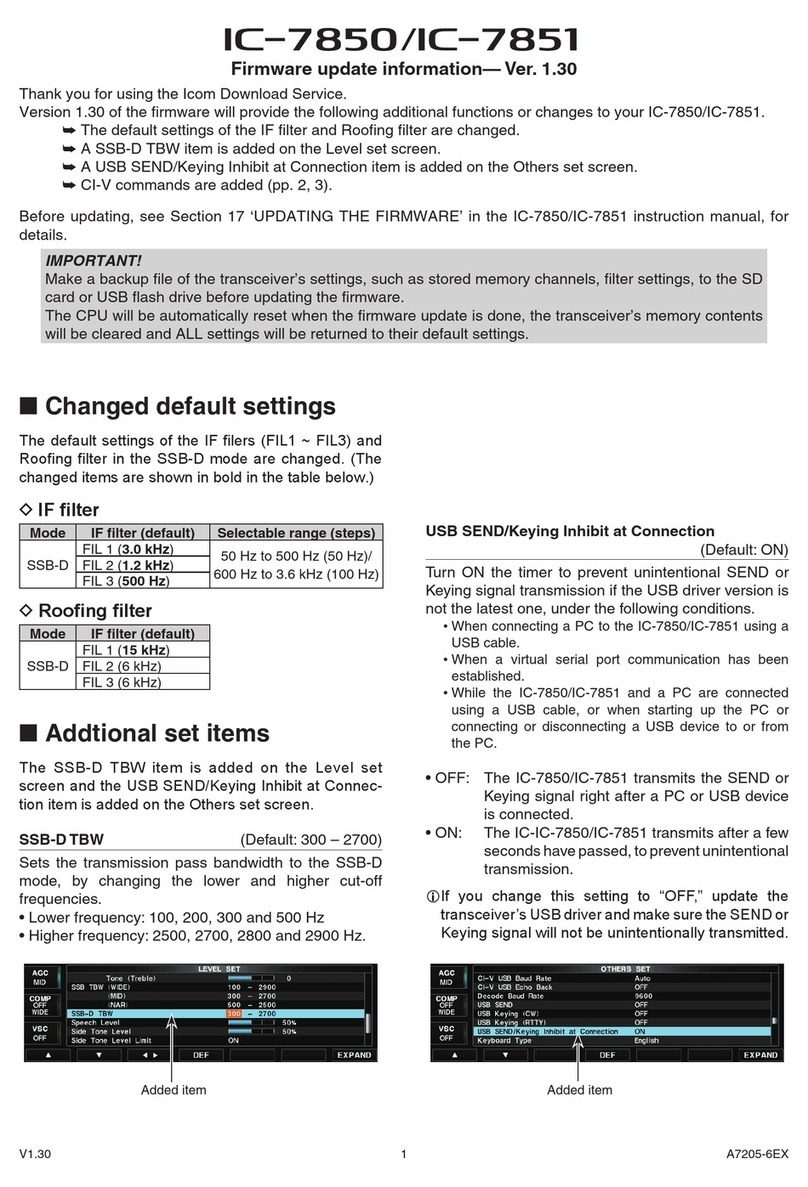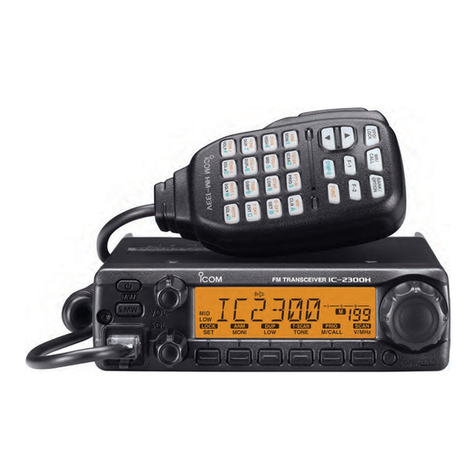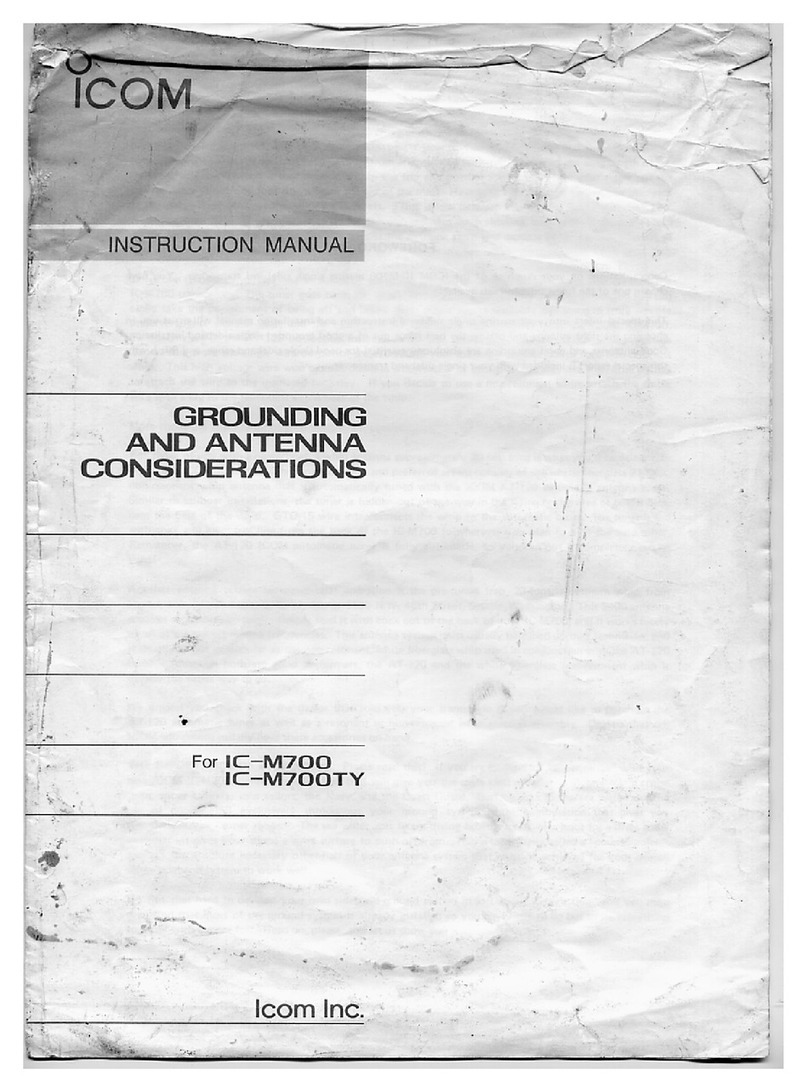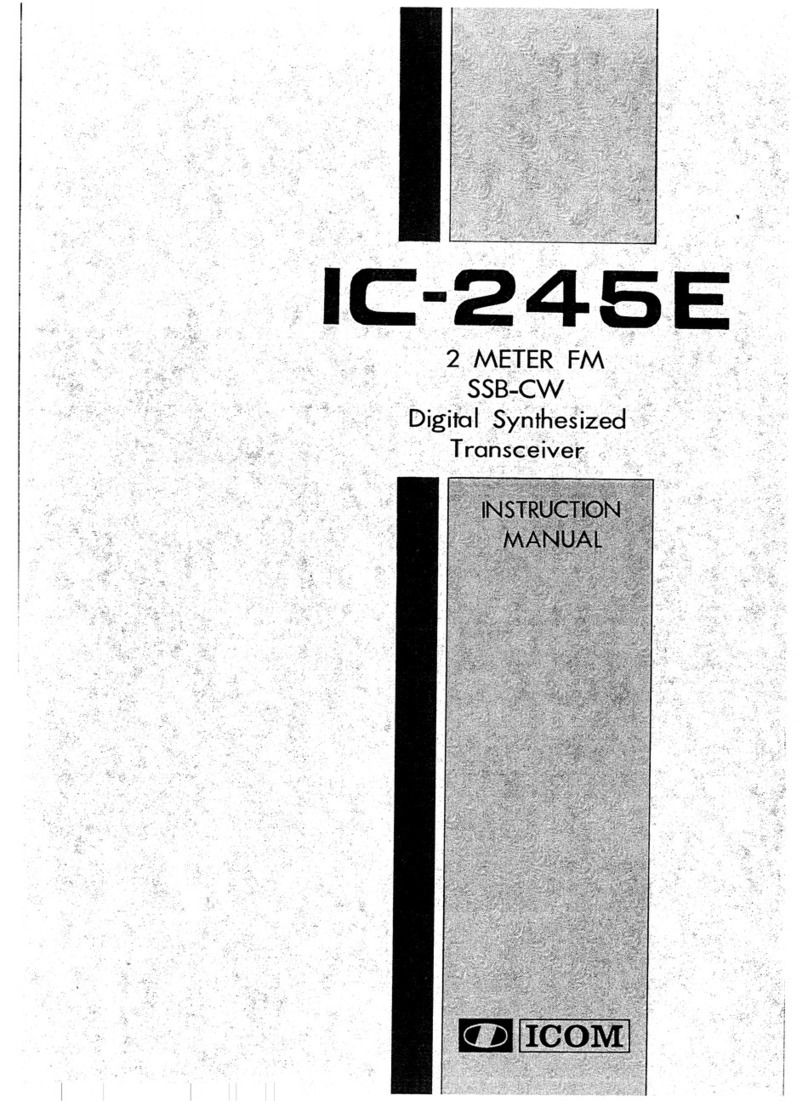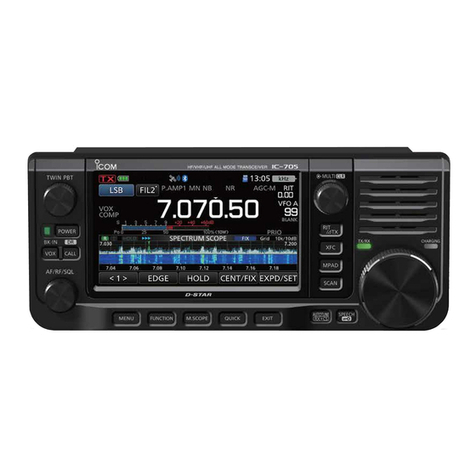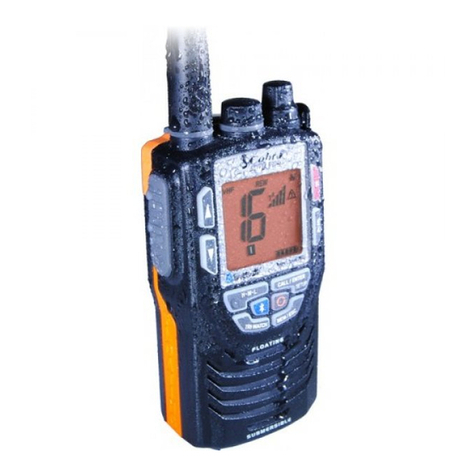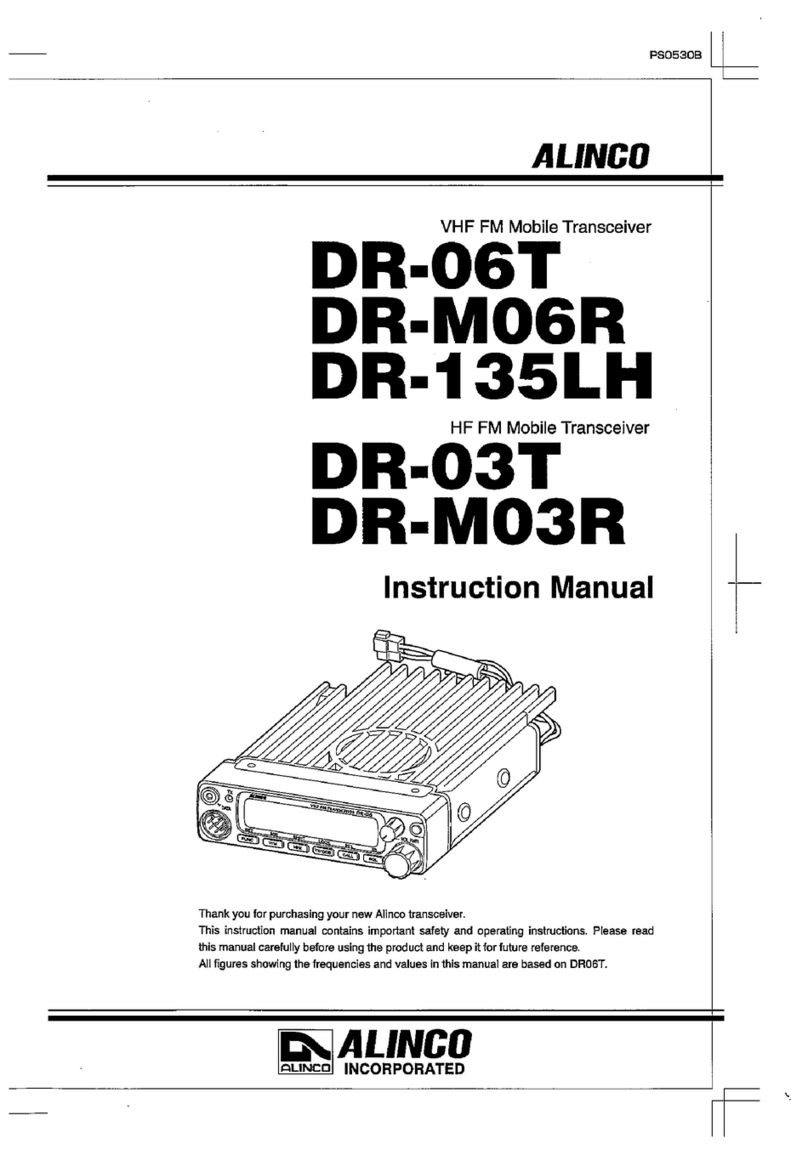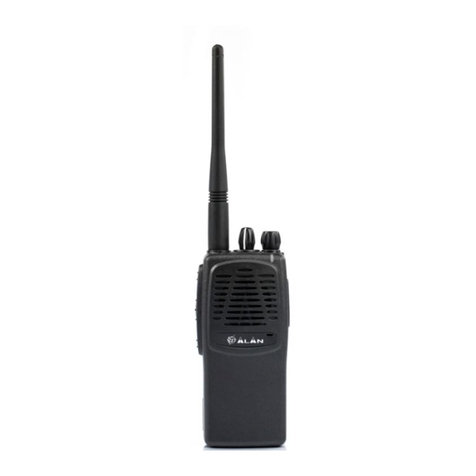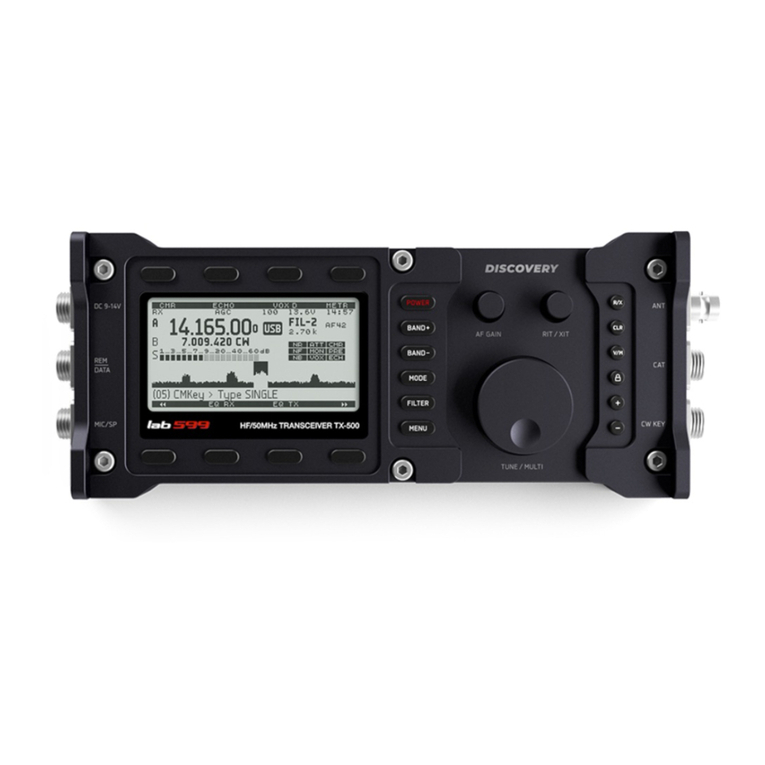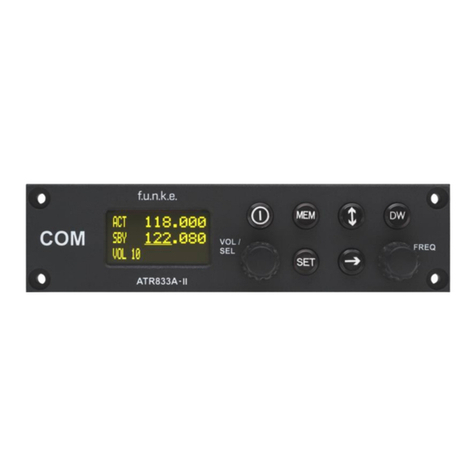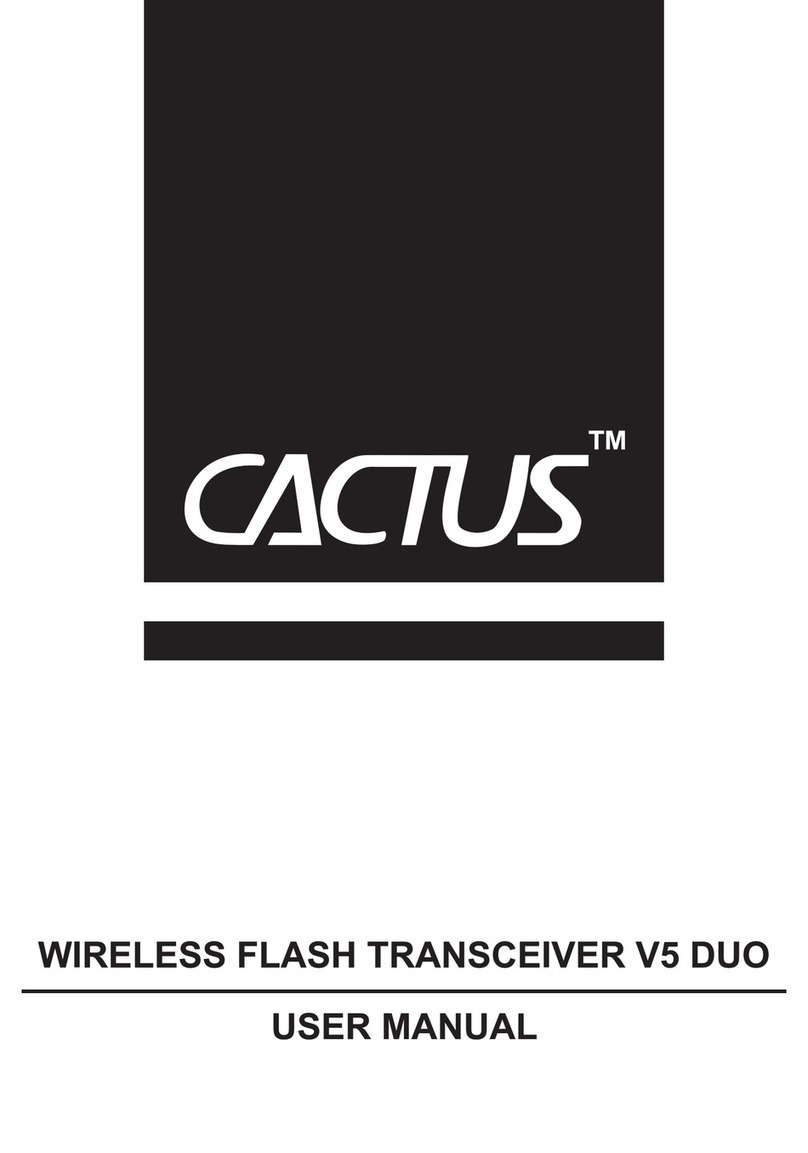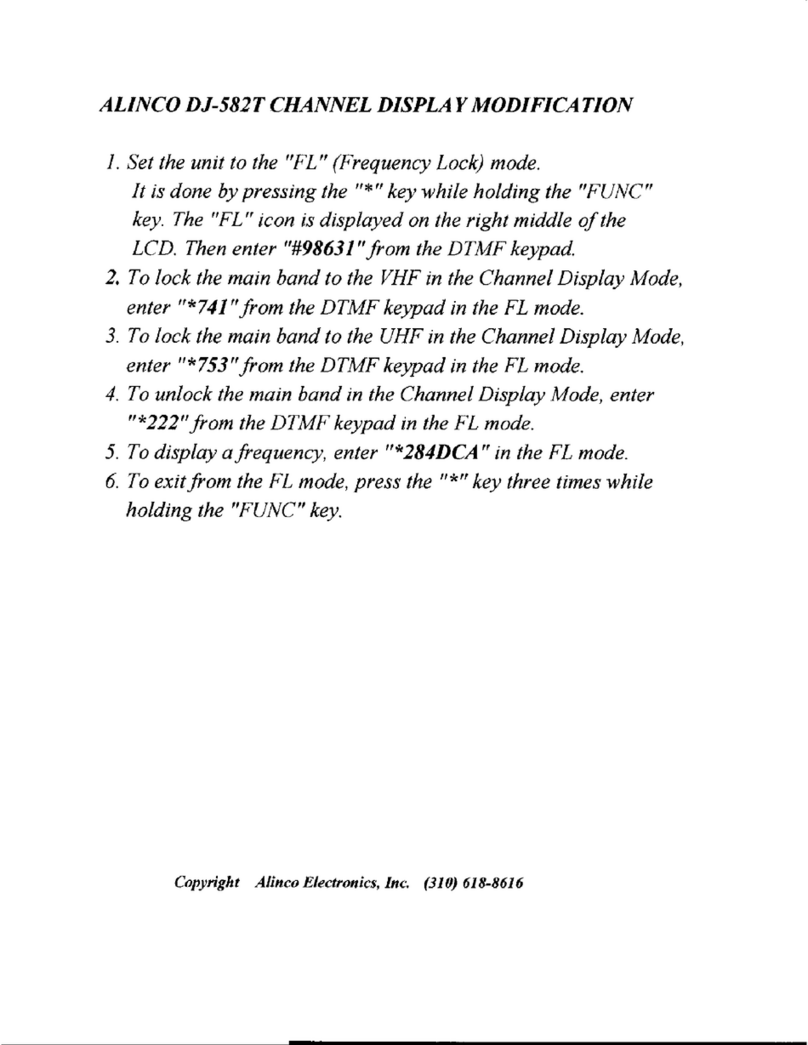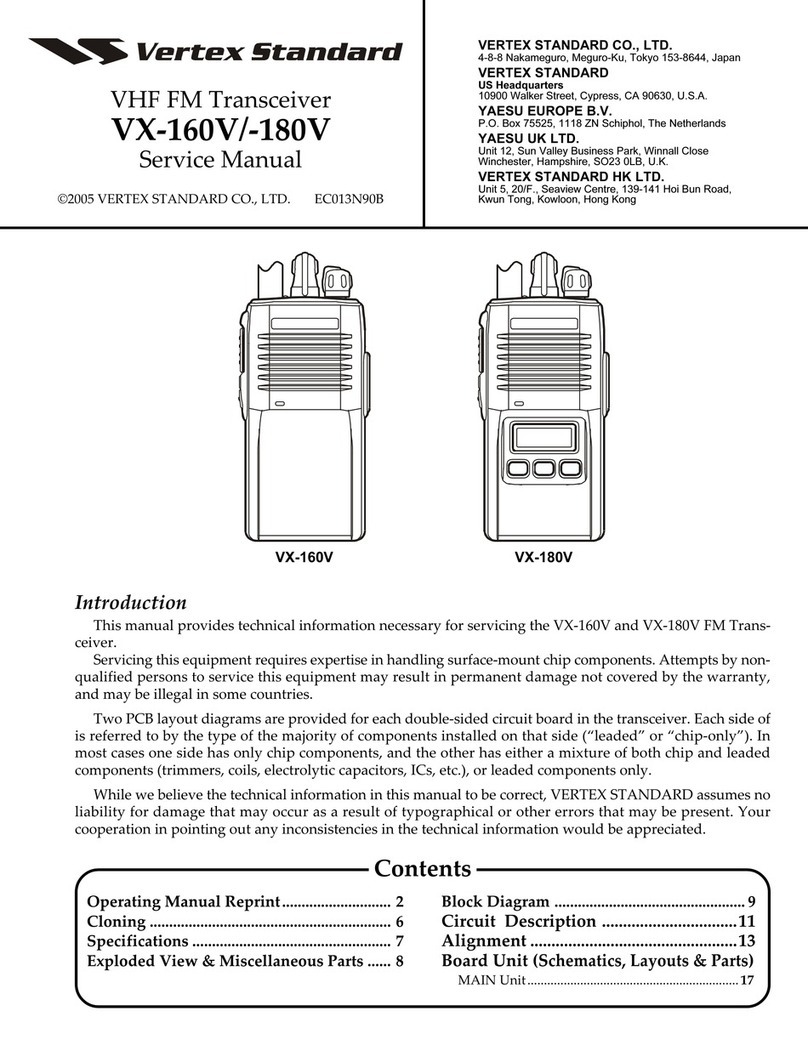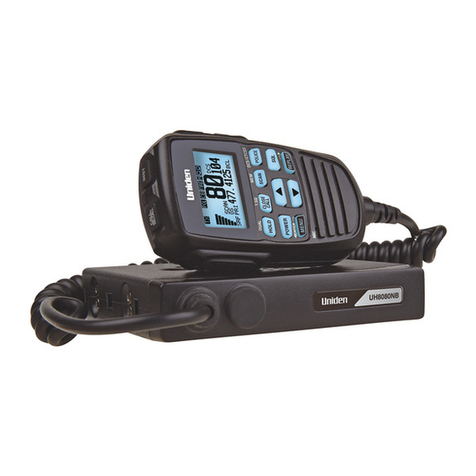Icom iF3011 User manual

INSTRUCTION MANUAL
This device complies with Part 15 of the FCC
Rules. Operation is subject to the condition
that this device does not cause harmful inter-
ference.
UHF TRANSCEIVERS
iF4011
iF4013
VHF TRANSCEIVERS
iF3011
iF3013

i
WARNING
Your Icom radio generates RF electromagnetic energy
during transmit mode. This radio is designed for and
classified as “Occupational Use Only”, meaning it must
be used only during the course of employment by indi-
viduals aware of the hazards, and the ways to minimize
such hazards. This radio is NOT intended for use by the
“General Population” in an uncontrolled environment.
This radio has been tested and complies with the FCC
and IC RF exposure limits for “Occupational Use Only”. In addition, your
Icom radio complies with the following Standards and Guidelines with
regard to RF energy and electromagnetic energy levels and evaluation
of such levels for exposure to humans:
• FCC OET Bulletin 65 Edition 97-01 Supplement C, Evaluating
Compliance with FCC Guidelines for Human Exposure to Radio
Frequency Electromagnetic Fields.
• American National Standards Institute (C95.1-1992), IEEE Standard
for Safety Levels with Respect to Human Exposure to Radio Fre-
quency Electromagnetic Fields, 3 kHz to 300 GHz.
• American National Standards Institute (C95.3-1992), IEEE Recom-
mended Practice for the Measurement of Potentially Hazardous
Electromagnetic Fields– RF and Microwave.
• The accessories (antennas, batteries, belt clips, speaker-micro-
phone, etc. that is listed on pages 32–34) are authorized for use
with this product. Use of accessories other than those specified may
result in RF exposure levels exceeding the FCC and IC require-
ments for wireless RF exposure.
CAUTION
To ensure that your expose to RF electromagnetic
energy is within the FCC and IC allowable limits for
occupational use, always adhere to the following
guidelines:
SAFETY TRAINING INFORMATION

SAFETY TRAINING INFORMATION
• DO NOT operate the radio without a proper antenna attached, as
this may damaged the radio and may also cause you to exceed
FCC and IC RF exposure limits. A proper antenna is the antenna
supplied with this radio by the manufacturer or antenna specifically
authorized by the manufacturer for use with this radio.
• DO NOT transmit for more than 50% of total radio use time (“50%
duty cycle”). “50% duty cycle” is also applicable to VOX/PTT mode.
Transmitting more than 50% of the time can cause FCC and IC RF
exposure compliance requirements to be exceeded. The radio is
transmitting when the “LED indicator” lights red. You can cause the
radio to transmit by pressing the “PTT” switch or VOX function.
• ALWAYS keep the antenna at least 2.5 cm (1 inch) away from
the body when transmitting and only use the Icom belt-clip which
is listed on page 33 when attaching the radio to your belt, etc., to
ensure FCC and IC RF exposure compliance requirements are not
exceeded. To provide the recipients of your transmission the best
sound quality, hold the antenna at least 5 cm (2 inches) from your
mouth, and slightly off to one side.
The information listed above provides the user with the information
needed to make him or her aware of RF exposure, and what to do to as-
sure that this radio operates with the FCC
and IC
RF exposure limits of
this radio.
Electromagnetic Interference/Compatibility
During transmissions, your Icom radio generates RF energy that can
possibly cause interference with other devices or systems. To avoid such
interference, turn off the radio in areas where signs are posted to do so.
DO NOT operate the transmitter in areas that are sensitive to electro-
magnetic radiation such as hospitals, aircraft, and blasting sites.
Occupational/Controlled Use
The radio transmitter is used in situations in which persons are exposed as
consequence of their employment provided those persons are fully aware
of the potential for exposure and can exercise control over their exposure.
ii

iii
Votre radio Icom produit une énergie électromagnétique
de radiofréquences (RF), en mode de transmission.
Cette radio est conçue pour un «usage professionnel
seulement» et classée comme tel, ce qui signifie qu’elle
doit être utilisée uniquement dans le cadre d’un travail
par des personnes conscientes des dangers et des me-
sures visant à minimiser ces dangers. Elle N’EST PAS conçue pour une
«utilisation grand public», dans un environnement non contrôlé.
Cet appareil a été évalué et jugé conforme, aux limites d’exposition
aux RF de la FCC et d’IC, pour une «utilisation grand public». En outre,
votre radio Icom satisfait les normes et directives qui suivent en matière
de niveaux d’énergie et d’énergie électromagnétique de RF et d’évalua-
tion de tels niveaux en ce qui concerne l’exposition humaine:
• Supplément C, édition 97-01, du Bulletin OET n° 65 de la FCC, «Eva-
luating Compliance with FCC Guidelines for Human Exposure to
Radio Frequency Electromagnetic Fields».
• Norme de l’American National Standards Institute (ANSI): IEEE
C95.1-1992 sur les niveaux de sécurité compatibles avec l’exposition
humaine aux champs électromagnétiques de radiofréquences (3 kHz
à 300 GHz).
• Norme de l’ANSI: IEEE C95.3-1992 sur la méthode d’évaluation re-
commandée du champ magnétique potentiellement dangereux des
radiofréquences et des micro-ondes.
• Les accessoires illustrés à la p. 32–34 sont approuvés pour une utilisa-
tion avec ce produit. L’utilisation d’accessoires autres que ceux précisés
peut entraîner des niveaux d’exposition aux RF supérieures aux limites
établies par la FCC et d’IC en matière d’exposition aux RF sans fil.
Afin de vous assurer que votre exposition à une
énergie électromagnétique de RF se situe dans
les limites permises par la FCC et d’IC pour une
utilisation grand public, veuillez en tout temps
respecter les directives suivantes:
INFORMATION EN MATIÈRE DE SÉCURITÉ

iv
• NE PAS faire fonctionner la radio sans qu’une antenne appropriée y soit
fixée, car ceci risque d’endommager la radio et causer une exposition su-
périeure aux limites établies par la FCC
et d’IC
. L’antenne appropriée est
celle qui est fournie avec cette radio par le fabricant ou une antenne spé-
cialement autorisée par le fabricant pour être utilisée avec cette radio.
• NE PAS émettre pendant plus de 50 % du temps total d’utilisation
de l’appareil («50 % du facteur d’utilisation»). La notion «50% du fac-
teur d’utilisation» s’applique également au mode VOX/PTT. Émettre
pendant plus de 50 % du temps total d’utilisation peut causer une
exposition aux RF supérieure aux limites établies par la FCC et d’IC.
Lorsque le voyant DEL rouge s’allume, cette radio est en train d’émet-
tre. La radio émettra si vous appuyez sur le bouton du microphone.
• TOUJOURS tenir l’antenne éloignée d’au moins 2,5 cm de votre corps
au moment d’émettre et utiliser uniquement l’attache pour ceinture Icom
illustrée à la p. 33, lorsque vous attachez la radio à votre ceinture, ou à
autre chose, de façon à vous assurer de ne pas provoquer une exposi-
tion aux RF supérieure aux limites fixées par la FCC et d’IC. Pour offrir
à vos interlocuteurs la meilleure qualité de transmission possible, tenez
l’antenne à au moins 5 cm de votre bouche et légèrement de côté.
Les renseignements ci-dessus fournissent à l’utilisateur toute l’information néces-
saire sur l’exposition aux RF et sur ce qu’il faut faire pour assurer que cette radio
fonctionne en respectant les limites d’exposition aux RF établies par la FCC et d’IC.
Interférence électromagnétique et compatibilité
En mode de transmission, votre radio Icom produit de l’énergie de RF
qui peut provoquer des interférences avec d’autres appareils ou sys-
tèmes. Pour éviter de telles interférences, mettez la radio hors tension
dans les secteurs où une signalisation l’exige. NE PAS faire fonctionner
l’émetteur dans des secteurs sensibles au rayonnement électromagné-
tique tels que les hôpitaux, les aéronefs et les sites de dynamitage.
Usage professionnel/contrôlé
Ce radio émetteur est utilisé dans des cas où des personnes sont expo-
sées en raison de leur travail, pourvu qu’elles soient conscientes du risque
d’exposition et qu’elles puissent exercer un contrôle sur cette exposition.
INFORMATION EN MATIÈRE DE SÉCURITÉ

v
FOREWORD
READ ALL INSTRUCTIONS carefully and completely before
using the transceiver.
SAVE THIS INSTRUCTION MANUAL— This instruction
manual contains important operating instructions for the IC-F3011/
IC-F3013 vhf transceivers and IC-F4011/IC-F4013 uhf trans-
ceivers.
EXPLICIT DEFINITIONS
WORD DEFINITION
RDANGER! Personal death, serious injury or an explo-
sion may occur.
RWARNING! Personal injury, fire hazard or electric shock
may occur.
CAUTION Equipment damage may occur.
NOTE
If disregarded, inconvenience only. No risk
of personal injury, fire or electric shock.
Icom, Icom Inc. and the Icom logo are registered trademarks of Icom Incorpo-
rated (Japan) in Japan, the United States, the United Kingdom, Germany, France,
Spain, Russia, Australia, New Zealand, and/or other countries.

vi
RDANGER! NEVER short terminals of the battery pack.
Also, current may flow into nearby metal objects such as a key, so
be careful when placing the battery packs (or the transceiver) in
handbags, etc. Simply carrying with or placing near metal objects
such as a key, etc. may cause shorting. This may damage not only
the battery pack, but also the transceiver.
RDANGER! Use and charge only specified Icom battery packs
with Icom transceivers or Icom chargers. Only Icom battery packs
are tested and approved for use with Icom transceivers or charged
with Icom chargers. Using third-party or counterfeit battery packs
or chargers may cause smoke, fire, or cause the battery to burst.
RWARNING! NEVER hold the transceiver so that the an-
tenna is very close to, or touching exposed parts of the body,
especially the face or eyes, while transmitting. The transceiver will
perform best if the microphone is 5 to 10 cm (2 to 4 in.) away from
the lips and the transceiver is vertical.
RWARNING! NEVER operate the transceiver with a headset
or other audio accessories at high volume levels. The continuous
high volume operation may cause a ringing in your ears. If you ex-
perience the ringing, reduce the volume level or discontinue use.
RWARNING! NEVER operate the transceiver while driving
a vehicle. Safe driving requires your full attention—anything less
may result in an accident.
PRECAUTIONS

vii
PRECAUTIONS (Continued)
CAUTION: MAKE SURE the flexible antenna, battery pack
and jack cover are securely attached to the transceiver, and that
the antenna and battery pack are dry before attachment. Exposing
the inside of the transceiver to dust or water will result in serious
damage to the transceiver.
CAUTION: NEVER
expose the transceiver to rain, snow or any
liquids. The transceiver may be damaged.
DO NOT operate the transceiver near unshielded electrical blast-
ing caps or in an explosive atmosphere.
DO NOT push [PTT] when you do not actually intend to transmit.
DO NOT operate or place the transceiver in direct sunlight or in
areas with temperatures below –30°C (+22°F) or above +60°C
(+140°F).
DO NOT modify the transceiver. The specifications may change
and then not comply with the requirements of a corresponded
regulation. The transceiver warranty does not cover any problems
caused by unauthorized modification.
DO NOT use harsh solvents such as benzine or alcohol when
cleaning, as they will damage the transceiver surfaces.
BE CAREFUL! The transceiver will become hot when operat-
ing it continuously for long periods of time.
MAKE SURE to turn OFF the transceiver power before con-
necting the supplied/optional equipment.

viii
FCC INFORMATION
• FOR CLASS A UNINTENTIONAL RADIATORS:
This equipment has been tested and found to comply with the limits
for a Class A digital device, pursuant to part 15 of the FCC Rules.
These limits are designed to provide reasonable protection against
harmful interference when the equipment is operated in a commer-
cial environment. This equipment generates, uses, and can radiate
radio frequency energy and, if not installed and used in accordance
with the instruction manual, may cause harmful interference to ra-
dio communications.
Operation of this equipment in a residential area is likely to cause
harmful interference in which case the user will be required to cor-
rect the interference at his own expense.
CAUTION: Changes or modifications to this device, not expressly
approved by Icom Inc., could void your authority to operate this
transceiver under FCC regulations.

ix
TABLE OF CONTENTS
SAFETY TRAINING INFORMATION.................................................... i
INFORMATION EN MATIÈRE DE SÉCURITÉ....................................iii
FOREWORD ....................................................................................... v
EXPLICIT DEFINITIONS..................................................................... v
PRECAUTIONS.................................................................................. vi
FCC INFORMATION .........................................................................viii
1 ACCESSORIES ......................................................................... 1–5
■Supplied accessories.................................................................. 1
■Accessory attachments .............................................................. 2
2 PANEL DESCRIPTION ............................................................ 6–11
■Front, top and side panels .......................................................... 6
■LED indicator .............................................................................. 8
■Programmable function keys ...................................................... 9
3 CONVENTIONAL OPERATION............................................. 12–15
■Turning power ON..................................................................... 12
■Channel selection ..................................................................... 12
■Receiving and transmitting ....................................................... 13
■Setting the squelch level........................................................... 15
4 SIGNALING OPERATIONS ................................................... 16–17
■Call procedure .......................................................................... 16
■Emergency Call ........................................................................ 17
■DTMF transmission................................................................... 17
5 BATTERY CHARGING .......................................................... 18–25
■Caution ..................................................................................... 18
■Battery chargers ....................................................................... 21
6 BATTERY CASE .................................................................... 26–27
■Optional battery case (BP-240) ................................................ 26
7 SWIVEL BELT CLIP .............................................................. 28–31
■MB-93 contents......................................................................... 28
■To attach ................................................................................... 28
■To detach .................................................................................. 30
8 OPTIONS ............................................................................... 32–35

1
1
ACCESSORIES
■Supplied accessories
The following accessories are supplied.
Flexible
antenna*
Battery pack Battery carger
(with power adapter)
Belt clip Jack cover (with screws)
*This illustration is described
with the VHF type.
1
2
3
4
5
6
7
8
9
10
11
12
13
14
15
16
17
18
19
20

2
1ACCESSORIES
■Accessory attachments
DFlexible antenna
Connect the supplied flexible antenna to
the antenna connector.
CAUTION:
• NEVER carry the transceiver by
holding only the antenna.
• DO NOT connect the antenna other
than listed on page 34.
• Transmitting without an antenna
may damage the transceiver.

3
1
ACCESSORIES
DBattery pack
To attach the battery pack:
Slide the battery pack on the back of the transceiver in the direction
of the arrow (q), then lock it with the battery release button.
• Slide the battery pack until the battery release button makes a ‘click’
sound.
To remove the battery pack:
Push the battery release button in the direction of the arrow (w) as
shown below. The battery pack is then removed.
NOTE: Keep the battery terminals clean. It’s a good idea to oc-
casionally clean them.
NEVER remove or attach the battery pack when the transceiver
is wet or soiled. This may result in water or dust getting into the
transceiver/battery pack and may result in the transceiver being
damaged.
q
w
Battery release
button
1
2
3
4
5
6
7
8
9
10
11
12
13
14
15
16
17
18
19
20

4
1ACCESSORIES
DJack cover
Attach the jack cover when the optional speaker-microphone is not
used.
To attach the jack cover:
qAttach the jack cover to the
[SP MIC] connector.
wTighten the screws.
To detach the jack cover:
eRemove the screws with a
phillips screwdriver.
rDetach the jack cover for the
optional equipment connec-
tion.
e
e
r
w
w
q

5
1
ACCESSORIES
DBelt clip
To attach the belt clip:
qRemove the battery pack if it is attached.
wSlide the belt clip in the direction of the arrow until the belt clip is
locked and makes a ‘click’ sound.
To detach the belt clip:
qRemove the battery pack if it is attached.
wPinch the clip (q), and slide the belt clip in the direction of the
arrow (w).
q
w
1
2
3
4
5
6
7
8
9
10
11
12
13
14
15
16
17
18
19
20

6
2PANEL DESCRIPTION
■Front, top and side panels
Microphone
Speaker
r
w
e
y
u
i
t
q
qCHANNEL SELECTOR
Rotate the channel selector to select the pre-programmed mem-
ory channels.
wVOLUME CONTROL [VOL]
Rotate to turn the power ON/OFF and adjust the audio level.

7
2
PANEL DESCRIPTION
eLED INDICATOR (p. 8)
➥Lights red while transmitting.
➥Lights green while receiving a signal, or when the squelch is
open.
➥Lights/blinks orange when the matched 2/5-Tone code is re-
ceived, according to the pre-programming. (For IC-F3013/
F4013 only)
rSPEAKER-MICROPHONE CONNECTOR [SP MIC]
Connects the optional speaker-microphone, earphone, etc.
[SP MIC] jack cover
NOTE: Attach the [SP MIC] jac
k
cover when the optional equip-
ment is not used. (p. 4)
tDEALER-PROGRAMMABLE KEY [Lower]
The desired function can be assigned by your dealer. (p. 9)
yPTT SWITCH [PTT]
Push and hold to transmit; release to receive.
uDEALER-PROGRAMMABLE KEY [Upper]
The desired function can be assigned by your dealer. (p. 9)
iANTENNA CONNECTOR
Connects the supplied antenna.
1
2
3
4
5
6
7
8
9
10
11
12
13
14
15
16
17
18
19
20

8
2PANEL DESCRIPTION
■LED indicator
The LED indicator indicates several information
as follows;
(Ref.; R=Red, G=Green, O=Orange)
R R R R
G G G G
G G
G G G G G G G G
R G R G R G R G R G R G R G R G
R O R O R O R O R O R O R O R O
G
G G
Clone Err
Clone TX/RX
Low BATT1
Low BATT2
Busy
F/S Scan
O O
O O
Call LED Blink
Call LED ON
TX Low BATT2
R
TX
• TX: Turns Red while transmitting a signal.
• RX: Turns Green while receiving a signal.
For IC-F3013/IC-F4013 only
• Call LED (ON): When receiving a matched 2/5-Tone.
• Call LED (Blink): When receiving a matched 2/5-Tone.
• Fast/Slow scan: Blinks while Fast/Slow scan is activated.
• Low BATT1:You should charge the battery. (blinks slowly)
• Low BATT2:You must charge the battery. (blinks fast)
• TX low BATT2: Low BATT2 was detected during TX mode.
• CH error: Non-programmed channel is selected.

9
2
PANEL DESCRIPTION
■Programmable function keys
The following functions can be assigned to [Upper] and [Lower]
programmable function keys.
Consult your Icom dealer or system operator for details concerning
your transceivers programming.
DFor All models
SCAN A KEY
➥Push to start and cancel scanning operation.
➥When the Power ON scan function is turned ON, push to pause
the scanning operation.The paused scan restarts after the spec-
ified time period has passed.
SCAN B KEY
Push to start and cancel scanning operation. In case of transmis-
sion during scan, pauses scanning. The paused scan restarts after
the specified time period has passed.
PRIORITY CHANNEL KEYS
➥Push to select the Priority A or Priority B channel.
➥Push and hold [Prio A (Rewrite)] to rewrite the Prio A channel.
MR-CH 1/2/3/4 KEYS
Push to select a memory channels 1 to 4 directly.
1
2
3
4
5
6
7
8
9
10
11
12
13
14
15
16
17
18
19
20

10
2PANEL DESCRIPTION
OUTPUT POWER SELECTION KEY
Select the transmit output power temporarily or permanently, de-
pending on the pre-setting.
• Ask your dealer for the output power level for each selection.
TALK AROUND KEY
➥Push to turn the talk around function OFF.
➥Push and hold to turn the talk around function ON.
• The talk around function equalizes the transmit frequency to the
receive frequency for transceiver-to-transceiver communication.
WIDE/NARROW KEY
➥Push to select the IF bandwidth to wide.
• The wide passband width can be selected from 25 or 20 kHz using
the optional cloning software (PMR operation only). Ask your dealer
for details.
➥Push and hold to select the IF bandwidth to narrow.
SIREN KEY
Push to emit a siren. This function can be used for situations other
than an emergency alert such as a security alarm for example.
LOCK KEY
Push and hold to electronically lock all programmable keys except
the followings:
[Moni(Audi)], [Call] (incl. Call A and Call B)* and
[Emergency Single]/[Emergency Repeat]
(incl. Silent)*.
* Available for IC-F3013/IC-F4013 only.
Other manuals for iF3011
1
This manual suits for next models
3
Table of contents
Other Icom Transceiver manuals
Popular Transceiver manuals by other brands
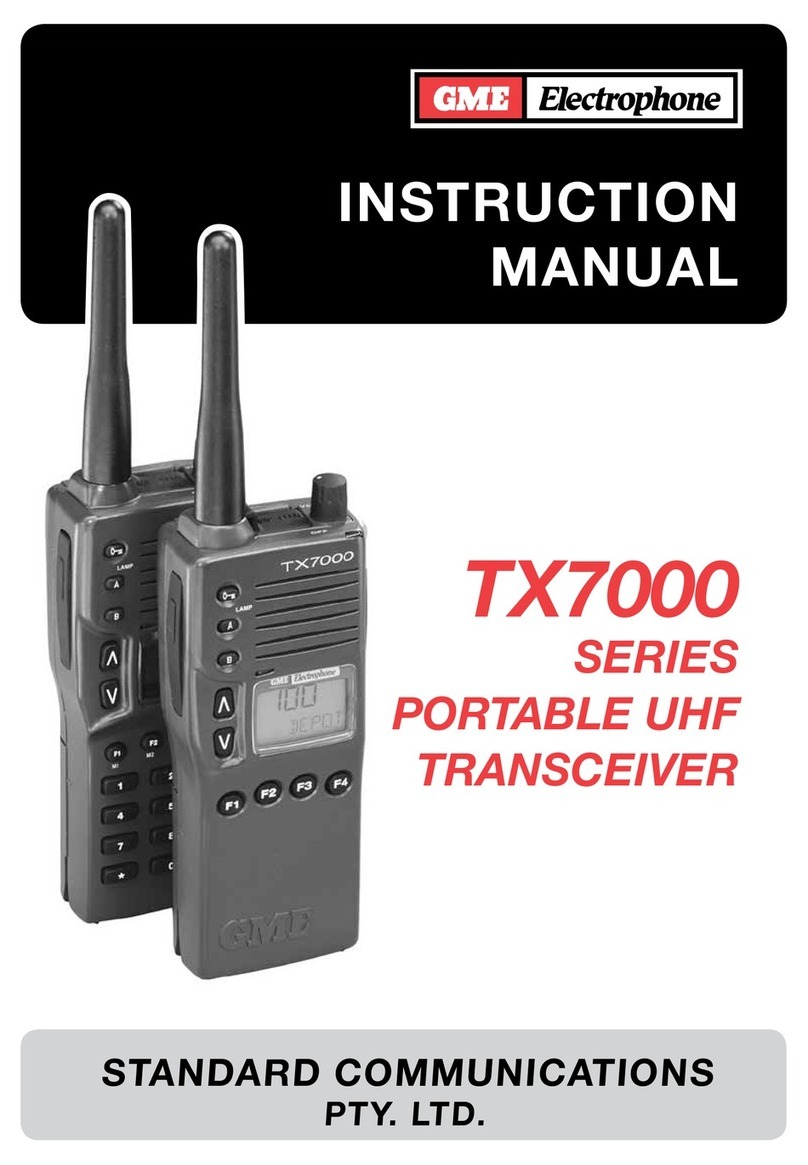
GME Electrophone
GME Electrophone TX7000 SERIES instruction manual
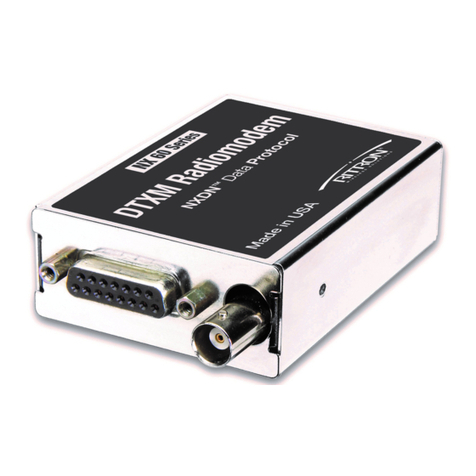
Ritron
Ritron DTXM-NXDN Series Maintenance & Operating Manual
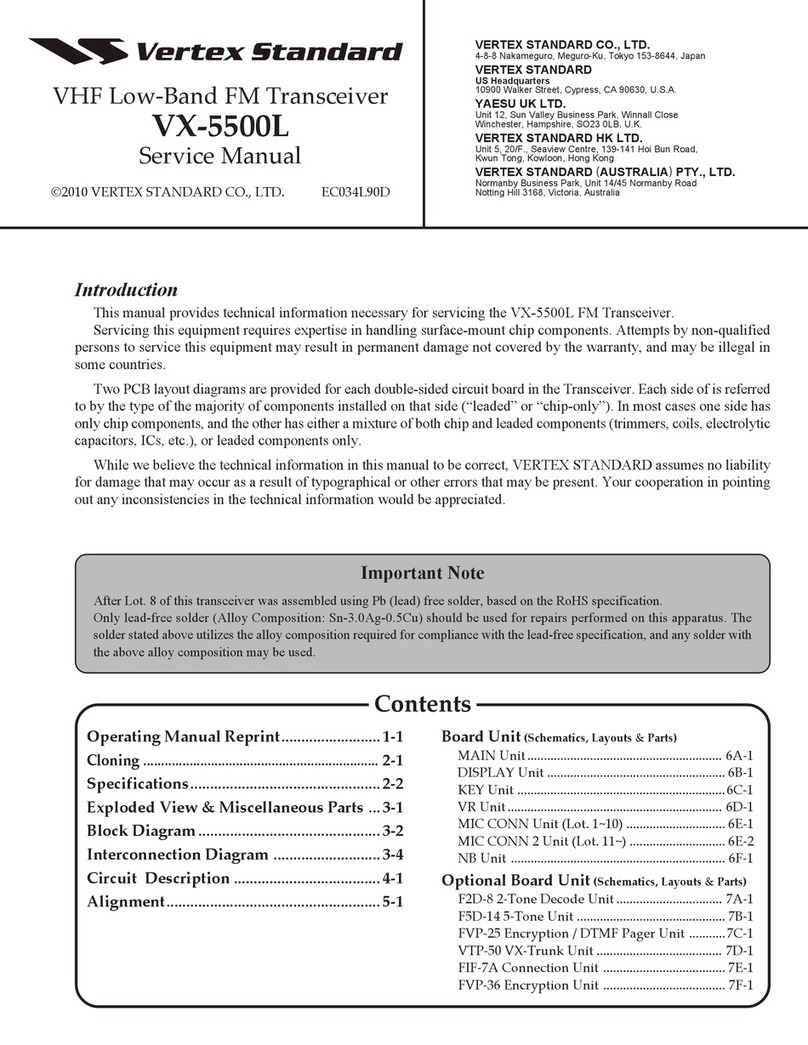
Vertex Standard
Vertex Standard VX-5500L Service manual
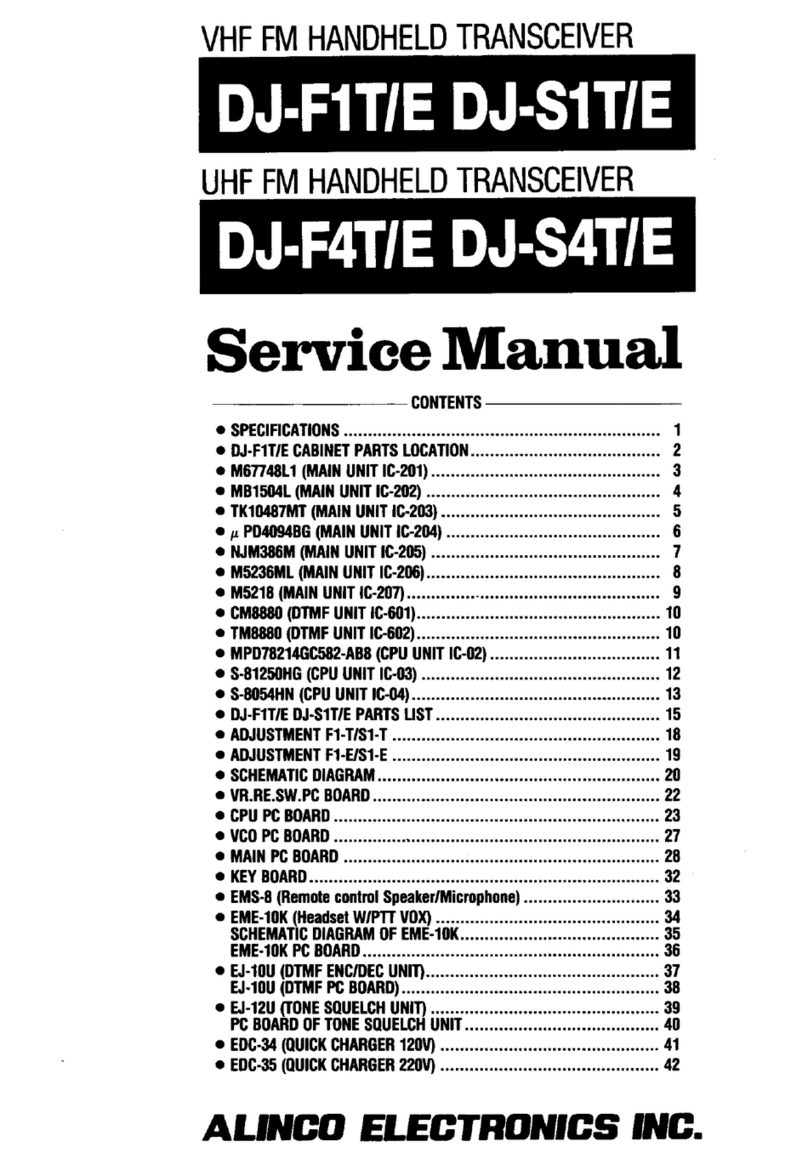
Alinco
Alinco DJ-F1T Service manual
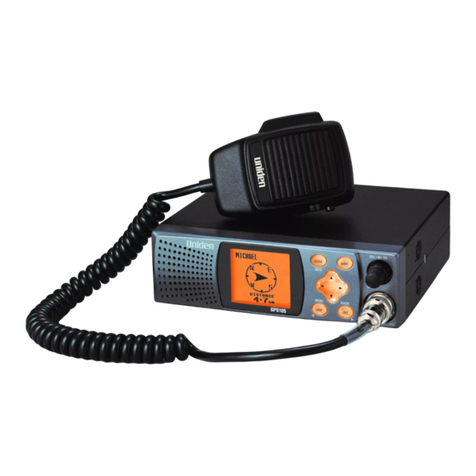
Uniden
Uniden GPS105 Operation manual

BWI Eagle
BWI Eagle AIR-EAGLE SR PLUS 36-4000-DC Product information bulletin

